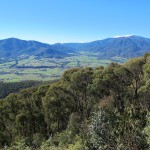
We missed the fall season last year because we moved to the southern hemisphere in July. For us, it’s been sixteen months straight without it, at least till now: winter-spring, then winter-spring-summer. And no fall. By May, we started seeing the usual signs of fall in the city, as the green departed the sycamores and other trees, revealing daubs of ochre and brown on the leaves before they fell.
So we took the advice of locals and drove up to the Victorian Alps, the tallest mountains in Australia along with their sisters in adjacent New South Wales. Here, we were told, you can see a richer display of the changing colors of fall, and we could toast the crisp, cold days of the mountains now crowned with early snows.
Red
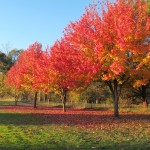
On the road from Melbourne, we first passed flat farmland, before finally ascending gradually through valleys amid low hills. Though you could see patches of yellow color along the way, the best displays were, as expected, in the area around the town of Bright, our destination.

Naturally, Bright is now the center of tourism in the area. A former mining town, it was named for the gold found here, not for any excess of sunlight reaching it in the cleft of the adjacent hills. Nearby the 6000 to 7000 foot mountains –Beauty, Buffalo, Bogong, Buller, Feathertop – offer hiking in the summer with grand vistas over the plains and skiing in the winter.
All the color comes from maples, elms and poplars brought originally by European settlers in the 19th century as recollections of dear old England or similar ones newly planted by locals to increase the colorful display of the season. The dominant native species, the eucalyptus, is not deciduous; its different varieties just exhibit various forms of green all year, though its flowers can be quite colorful. According to an Aussie friend, however, the native Tanglefoot Beech (Nothofagus gunnii) found only in Tasmania turns yellow and red in the fall.
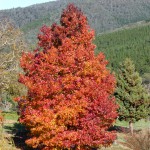
We might have missed the absolute peak of color a week or so earlier, but it was raining every day that week. Our days here were sunny instead, and we still found plenty of fall color to delight us – from the gold of poplars to the rich reds of maples, with subtler hues of oaks, elms and others blended in amidst the backdrop of evergreen natives. On the ground around so many of the trees, halos of fallen leaves glowed as if reflecting the color above them. Everywhere we went around Bright, we found brilliant trees and groupings to admire. Like paparazzi, we photographed persistently to try and capture the effect. At least a bit of the splendor showed on the screen.
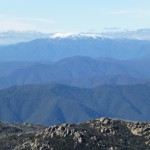
With snow already covering the mountaintops, we couldn’t help but recognize how fall brings a special form of tension as well.
Spring brings new life from the ground, and relief from the cold and isolation of winter. It’s the season of hope, the lengthening light, the greening time. Spring, literally, has a bounce in its step.
Fall brings a different knowledge – of the coming cold, the urgency for all life to store food. It’s the season of fading out, the ebbing of light, and soon barren trees. Fall threatens.
At least, we have the balm of this color, as the green of spring is transformed into the rainbow colors of dying leaves, whose decay will later return nutrients back to the trees. And the recognition that the coming winter will soon yield again to the new life of spring.
White
After Bright, our plan was to drive south by the Alpine highway among the snow-capped mountains. We had seen these from Bright and from atop the nearby Mt. Buffalo, to whose snow-less peak – the “Horn” – we had hiked. Then we would drop down to the sea along with the rivers descending from the Alps.
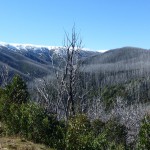
We passed through other valleys whose colors echoed Bright’s and along twisting roads through the lesser hills and mountains. Approaching the ski resort of Falls Creek, we ascended to the highest point on the road. You could see quite a bit of snow atop the near peaks, but it was the other white on the hillsides that caught our attention. Ashen white spikes covered both the near and distant hills for miles, as if a Tolkien army of lean spectres had gathered about us. It was apparent, from the ones closest to us, that these were tall eucalyptus trees, roasted by a massive fire a decade ago and now bleached white like bones. The dead trees made for an eerie winter landscape.
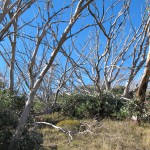
But even here, we knew, life was renewing all around us. For these eucalyptus, like other native species, are particularly adapted to endure fire’s destruction. The tree hides its seeds in oily protection so the fire actually releases the seeds to start new life, even as the parent tree dies. The roots and stumps, relatively protected during a fire, can also sprout new saplings. In fact, at the base of most nearby trees, and in the dark amid the distant spectres, we could see how new trees were already emerging from the productive effects of that old fire. On Mt. Buffalo, likewise, we had seen new snow gum trees twined around the bases of the old burnt ones. Here and there, we could just about see how the new trees gained protection and nourishment from the slowly decaying trees that spawned them. Even in high places already gripped by winter, new life was thriving.
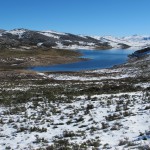
As we stared, a couple from Sydney also pulled off the road. The 80-year old man started snapping pictures of the spectacle, then reaffirmed what we knew about these reviving trees. And he was an expert, a long-time landscape architect who still consulted on projects like an important new one in Sydney Harbor.
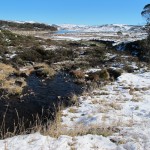
He admitted that he loved this alpine area more than any other in Australia, and wished he could return decade after decade to watch the progress of the hills as they grew green again with the maturing trees.
Past Falls Creek resort, we reached a high alpine bowl covered with a light snow layer soon to become a lot deeper. We rounded a shallow lake constantly renewed by underground water squeezed from the spongy ground as well as melted snow. All around us, we could hear rivulets trickle and flow. And we could feel the gnarled trees and dormant grasses patiently enduring the winter.
Blue
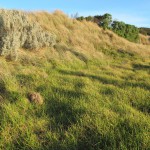
We followed the route by which the alpine rivers fall to the sea, down Melbourne’s side of the Great Dividing Range. This brought us to an area of lakes and estuaries about 90 miles east of Melbourne. Between these lakes and the Southern Ocean a 50 foot wide spit of dune-backed beach, appropriately called 90 Mile Beach, stretches some 30 miles east and west.
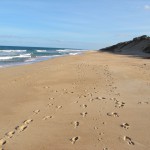
At the shore’s far eastern end, wedged between bulbous Lake Victoria and meandering waterways, Lakes National Park offers a sandy track you can drive through the bush and miles of walking trails leading from the track to the waters. The remaining stretch of beach is almost pristine. Though a few towns and quite a number of holiday homes sit along the sealed road, you can walk the whole length of this sandy shoreline without seeing one house: the structures and road are all hidden behind the tall dunes.
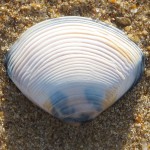
We stopped at Paradise Beach, an apt name for the entire shore, but just one of dozens and dozens of access points. Emerging from the greens and browns of the dune scrub, we delighted at the seemingly endless lines of foamy white surf and orange-cream sands against the ocean blue. We walked the shoreline, but found few shells to enjoy, and even those just bleached and broken remnants of the mollusks who occupied them. We often judge the health of the water by an abundance of shells, and this beach seemed dead. A bit farther down the beach, we saw that high tide had built up tiny embankments; half way up, a line of old shells peeked out, as if someone had stuck them into the short wall as a memorial.
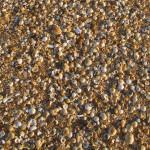
But, further on, we began to notice parts of the beach covered with bivalve shells – thousands of them, and different from what we had been seeing.
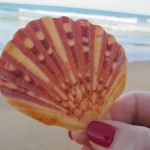
Most were still perfectly formed, often with the two halves still joined together and open. The living creatures had vacated long before, whether dying naturally or, despite the intact shells, eaten by birds or other sea life.
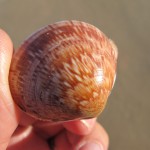
But they had left the most amazing variety of colors and patterns – arcs of blue, Aztec-like browns, zebra stripes, rays of peach and orange, even lime green. Some of their shells displayed spectacular coloration on the outside, as we would expect; others, oddly, were brilliantly painted on the inside, a kind of internalized delight for the mollusk, it would seem.
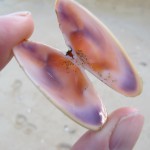
A virtual rainbow adorned the interior of our favorite, despite a bland exterior. Some of the complex patterns were repeated in other shells; others seemed unique and unrepeatable.
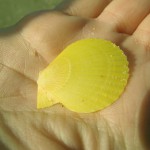
We became obsessed by these miniature masterpieces of color and line, more precious because, like the leaves at Bright, they seemed to us a transitory delight. We could only enjoy the shells because the mollusks had died, their nutrients now passed along to a predator or swishing about offshore. Soon, these colorful remains would be bleached and battered into granules of sand like those on which the shells now lay.
—-
Red leaves, white eucalyptus, blue shells, and all the rest of the rainbow – uplifted by the lively colors of the dying fall.
(Also, for more pictures from Australia, CLICK HERE to view the slideshow at the end of the Australia itinerary page.)



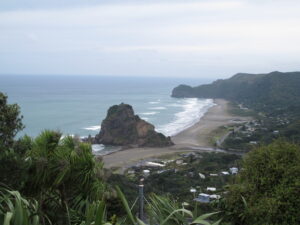
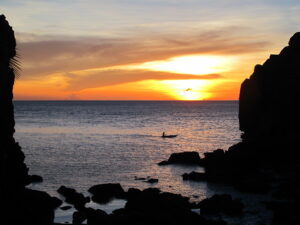
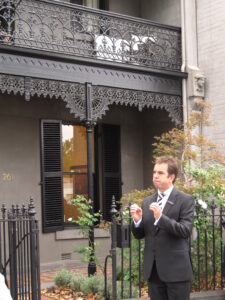
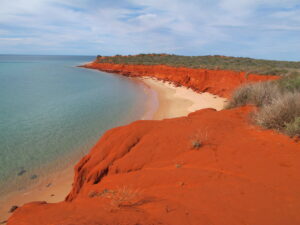
Great post, love it!